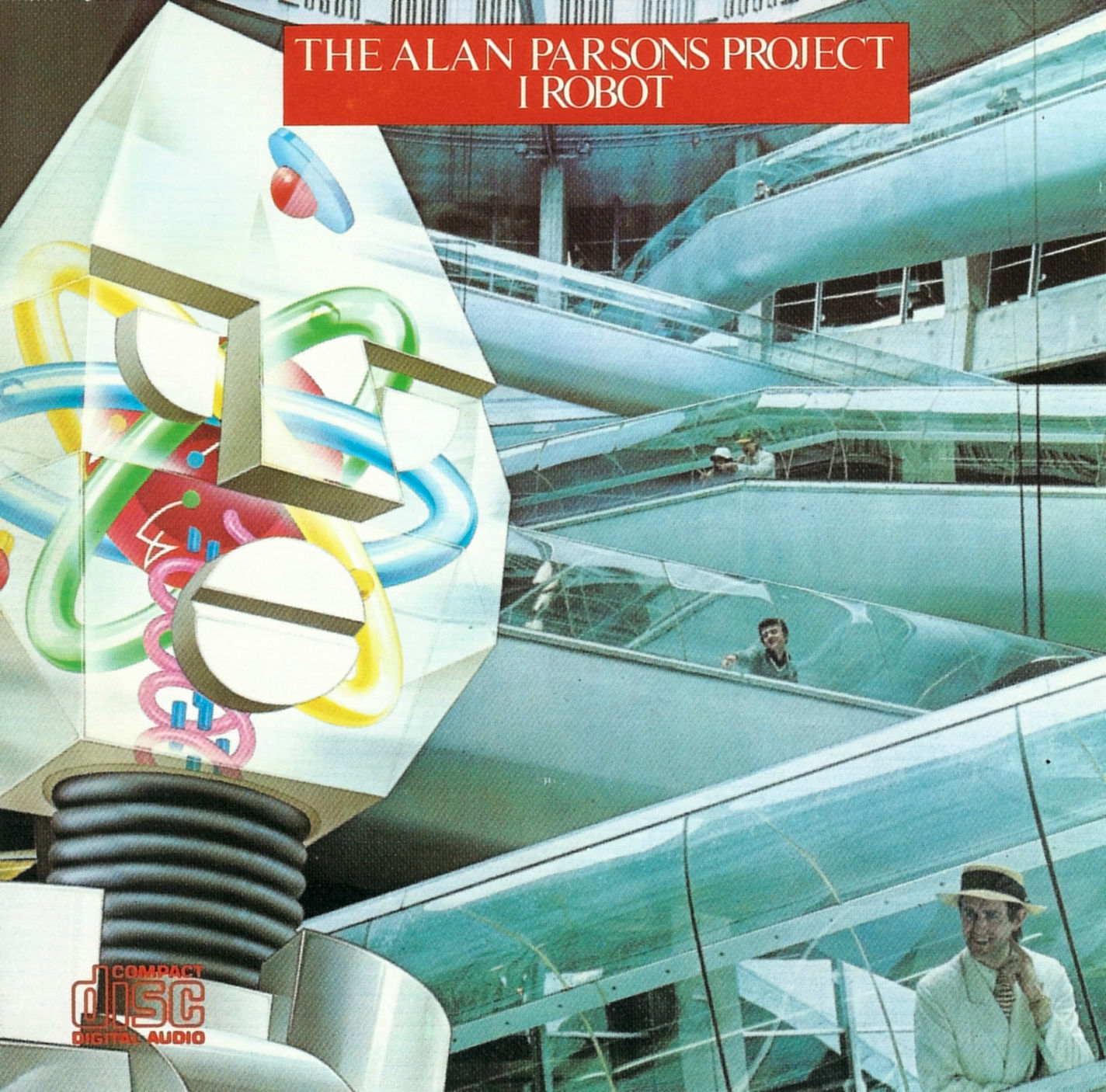
Alan Parsons Project – I, Robot
 This album set the pace for the Alan Parsons Project for the remainder of the 1970s, though in a way it pales in comparison to most of the rest of the Project’s output. A theme album about a grim, technology-dominated future, I, Robot suffers a fate uncommon to most other Parsons albums – it suffers from being a product of its time. The result is a disco leaning that is hard to swallow – most of the attempts at disco on this album aren’t even necessarily skillful! At the same time, you probably remember the single “Breakdown” from this album, as well as a song that Pat Benatar later covered, “Don’t Let It Show”. This latter song begins a fine tradition on Parsons’ albums, what I call the Parsons Heartbreaker – very somber, poignant songs that have a tendency to deposit a lump in the throat of the listener. “Don’t Let It Show” features the recently deceased trying to deliver one last message back to the world of the living, and even with a hint of hopefulness, it’s a depressing song – even the cathedralesque organ in the tune’s opening seconds seems to transport you to a chapel full of people dressed in black. If you can
This album set the pace for the Alan Parsons Project for the remainder of the 1970s, though in a way it pales in comparison to most of the rest of the Project’s output. A theme album about a grim, technology-dominated future, I, Robot suffers a fate uncommon to most other Parsons albums – it suffers from being a product of its time. The result is a disco leaning that is hard to swallow – most of the attempts at disco on this album aren’t even necessarily skillful! At the same time, you probably remember the single “Breakdown” from this album, as well as a song that Pat Benatar later covered, “Don’t Let It Show”. This latter song begins a fine tradition on Parsons’ albums, what I call the Parsons Heartbreaker – very somber, poignant songs that have a tendency to deposit a lump in the throat of the listener. “Don’t Let It Show” features the recently deceased trying to deliver one last message back to the world of the living, and even with a hint of hopefulness, it’s a depressing song – even the cathedralesque organ in the tune’s opening seconds seems to transport you to a chapel full of people dressed in black. If you can  survive this song, the rest of the album is listenable, if somewhat average. At the time, it must’ve been an amazing sound – 1977 was a good year for orchestrated rock between this album and ELO’s Out Of The Blue. This album also features the first lead vocal by Project cofounder Eric Woolfson, whose Orbisonesque vocals you’ll probably remember from later hits “Eye In The Sky” and “Time”.
survive this song, the rest of the album is listenable, if somewhat average. At the time, it must’ve been an amazing sound – 1977 was a good year for orchestrated rock between this album and ELO’s Out Of The Blue. This album also features the first lead vocal by Project cofounder Eric Woolfson, whose Orbisonesque vocals you’ll probably remember from later hits “Eye In The Sky” and “Time”.
- I, Robot (6:01)
- I Wouldn’t Want To Be Like You (3:23)
- Some Other Time (4:05)
- Breakdown (3:53)
- Don’t Let It Show (4:25)
- The Voice (5:24)
- Nucleus (3:22)
- Day After Day (The Show Must Go On) (3:57)
- Total Eclipse (3:13)
- Genesis Ch. I v. 32 (3:24)
Released by: Arista
Release date: 1977
Total running time: 41:07
The Jeff Lynne Years, 1968-1973
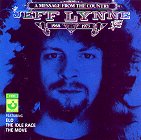 This is a handy collection of some of the earliest recorded works by my favorite performer/songwriter in all of rock ‘n’ roll, Jeff Lynne of ELO fame. Even in the late 60’s tunes he wrote for his band Idle Race, it’s easy to hear the Lennon/McCartney influences – actually not so much easy to hear them, but impossible to miss them. In some cases, the quirky melodies and harmonies almost hit one over the head with their Beatle-ish-ness – at this early stage in his career, Lynne probably had yet to incorporate musical influences other than his beloved Fab Four into his work. Still, while much of the Move and ELO music on this album can be heard elsewhere (and, indeed, are reviewed elsewhere here), the
This is a handy collection of some of the earliest recorded works by my favorite performer/songwriter in all of rock ‘n’ roll, Jeff Lynne of ELO fame. Even in the late 60’s tunes he wrote for his band Idle Race, it’s easy to hear the Lennon/McCartney influences – actually not so much easy to hear them, but impossible to miss them. In some cases, the quirky melodies and harmonies almost hit one over the head with their Beatle-ish-ness – at this early stage in his career, Lynne probably had yet to incorporate musical influences other than his beloved Fab Four into his work. Still, while much of the Move and ELO music on this album can be heard elsewhere (and, indeed, are reviewed elsewhere here), the  Idle Race songs are truly well-crafted for their time, and considering that Lynne was just venturing into songwriting. “Follow Me Follow”, “Girl At The Window” and especially “Come With Me” – the latter with more than a little George Harrison flavor – are exceptional, and “The Birthday Party”, which was Lynne’s first outing as a producer and also his first experience with a string section, is particularly interesting.
Idle Race songs are truly well-crafted for their time, and considering that Lynne was just venturing into songwriting. “Follow Me Follow”, “Girl At The Window” and especially “Come With Me” – the latter with more than a little George Harrison flavor – are exceptional, and “The Birthday Party”, which was Lynne’s first outing as a producer and also his first experience with a string section, is particularly interesting.
- Do Ya (4:05 – The Move, 1972)
- The Minister (4:30 – The Move, 1971)
- Girl at the Window (3:46 – Idle Race, 1969)
- Roll Over Beethoven (4:35 – ELO, 1972)
- Words of Aaron (5:28 – The Move, 1971)
- Mr. Radio (5:05 – ELO, 1971)
- The Skeleton and the Roundabout (2:21 – Idle Race, 1968)
- Message From the Country (4:48 – The Move, 1971)
- Come With Me (2:45 – Idle Race, 1969)
- Morning Sunshine (1:49 – Idle Race, 1968)
- 10538 Overture (5:42 – ELO, 1971)
- Happy Birthday/The Birthday (3:24 – Idle Race, 1968)
- No Time (3:42 – The Move, 1971)
- Showdown (4:11 – ELO, 1973)
- In Old England Town (6:53 – ELO, 1972)
- Big Chief Wooly Bosher (5:17 – Idle Race, 1969)
- Queen of the Hours (3:24 – ELO, 1971)
- Follow Me Follow (2:46 – Idle Race, 1968)
Released by: EMI
Release date: 1989
Total running time: 74:31
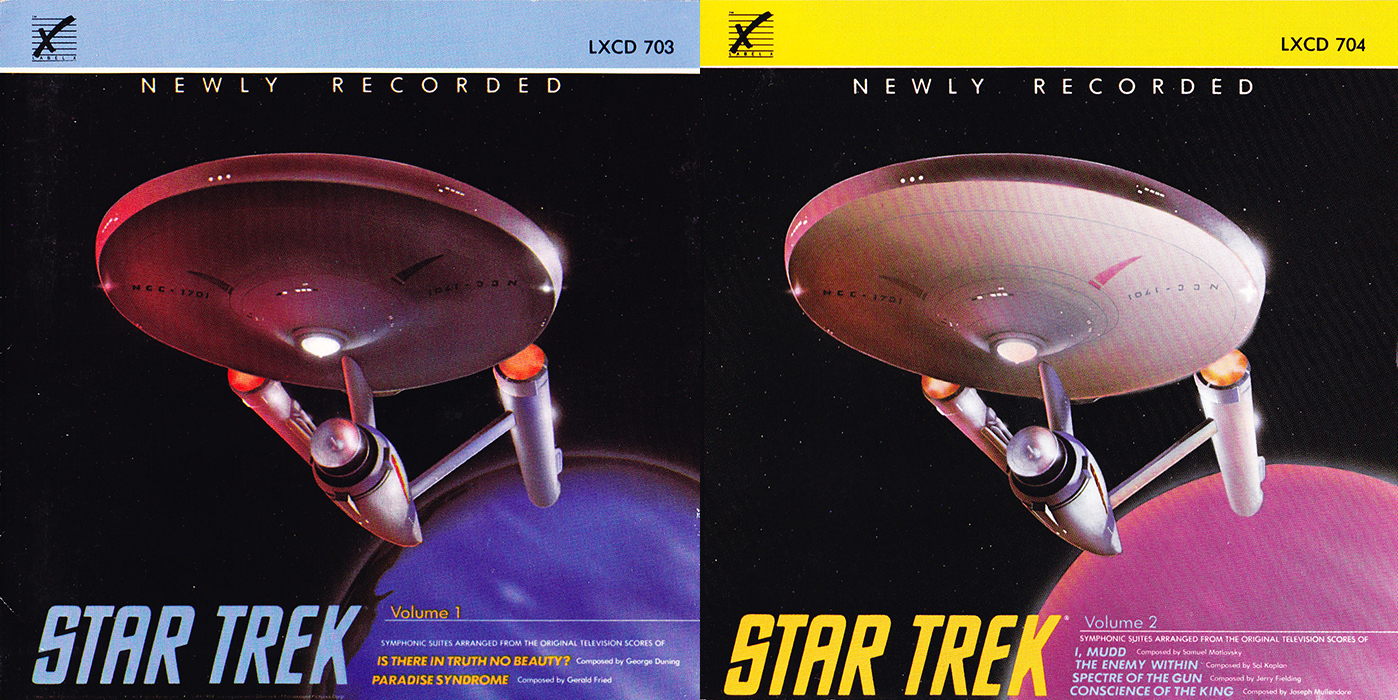
Star Trek: Symphonic Suites from the Original Series
 Released around the 20th anniversary of Star Trek, these two CDs contained new recordings of the original Trek’s music, this time in the form of long suites in which the entirety of particular episode’s score is performed in the form of a long, interconnected orchestral piece. The arrangements are faithful, but you have to have a stomach for 15 or more minutes of music in the classic Trek vein; remember, compared to the almost atonal sophisticated stuff that passes for music on the current Star Trek shows, the old Trek’s scores were pretty wildly bombastic. Both discs were performed by the Royal Philharmonic Orchestra, conducted by Tony Bremner. Volume 1 features the music of the third-season episodes Is There In Truth No Beauty? and The Paradise Syndrome, composed by, respectively, George Duning and Gerald Fried, while Volume 2’s more diverse selection includes Joseph Mullendore’s The Conscience Of The King and Sol Kaplan’s The Enemy Within from the first season, the whimsical I, Mudd score by Samuel Matlovsky from the second year, and the third year’s Spectre Of The Gun, composed by Jerry Fielding. The shortcomings of these discs are some very irritating synthesized approximations of the organ tones used in the very 1960s original
Released around the 20th anniversary of Star Trek, these two CDs contained new recordings of the original Trek’s music, this time in the form of long suites in which the entirety of particular episode’s score is performed in the form of a long, interconnected orchestral piece. The arrangements are faithful, but you have to have a stomach for 15 or more minutes of music in the classic Trek vein; remember, compared to the almost atonal sophisticated stuff that passes for music on the current Star Trek shows, the old Trek’s scores were pretty wildly bombastic. Both discs were performed by the Royal Philharmonic Orchestra, conducted by Tony Bremner. Volume 1 features the music of the third-season episodes Is There In Truth No Beauty? and The Paradise Syndrome, composed by, respectively, George Duning and Gerald Fried, while Volume 2’s more diverse selection includes Joseph Mullendore’s The Conscience Of The King and Sol Kaplan’s The Enemy Within from the first season, the whimsical I, Mudd score by Samuel Matlovsky from the second year, and the third year’s Spectre Of The Gun, composed by Jerry Fielding. The shortcomings of these discs are some very irritating synthesized approximations of the organ tones used in the very 1960s original  renditions. On the other hand, these are the only available copies of these specific episodes’ music, and a lot of it is very good indeed, particularly since, unlike the GNP Crescendo releases, much of the music comes from the third season, and therefore was not reused over and over again as often as the earlier music from the first and second seasons.
renditions. On the other hand, these are the only available copies of these specific episodes’ music, and a lot of it is very good indeed, particularly since, unlike the GNP Crescendo releases, much of the music comes from the third season, and therefore was not reused over and over again as often as the earlier music from the first and second seasons.
Volume One
- Is There In Truth No Beauty? by George Duning:
Enter Miranda / Ambassador Arrival / McCoy’s Toast / Quite a Woman / Marvick Pleads / Marvick Mad / Marvick Berserk / Marvick Dies / Sentimental Jim /Blind Miranda / No Chane / Miranda Mad / Miranda’s Farewell (19:58)- The Paradise Syndrome by Gerald Fried:
Pine Trees / The Amerinds / Tahiti Syndrome / The Brain Wash / Miramanee / Breath of Life / The New God / Dilithium Problem / Wash Day / Salish Fluffed / Potter Kirk / Naming the God / Joining Day / Challenge / The Ceremony / Birth Announcement / False God / Death of Miramanee (19:54)Volume Two
- The Conscience Of The King by Joseph Mullendore:
Spaceship Titles / Lenore / Lenore’s Kiss / Everything Is Later / Ophelia Mania / Last Cue (8:43)- Spectre Of The Gun by Jerry Fielding:
Melkot’s Warning / Tomstone / Teeth Pulling / My Name: Doc Holliday / Love Scene in the Old West / Chekov Gets Killed / Ten Minutes / We’re Trapped / Final Curtain (15:15)- The Enemy Within by Sol Kaplan:
The Rock Slide / The Tired Captain / Bruised Knuckles / An Imposter / Undecisive / Alter Ego / Another Brandy / Double Dog Death / Help Me / Thank You, Yeoman (13:14)- I, Mudd by Samuel Matlovsky:
Alice In Wonderland / Mudd’s Series / Tired of Happiness / Stella / The Last Straw / Stella 500 (8:38)Released by: Label X
Release date: 1986
Volume One total running time: 39:52
Volume Two total running time: 45:53
Peter Gabriel – So
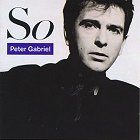 This album, and the singles “Sledgehammer” and “Big Time”, were my first real exposure to Peter Gabriel, which is the case with a lot of people. This is easily Gabriel’s most accessibly mainstream album, but even with that in mind, it bears more than a casual listen. And it’s still my favorite, mainly due to simple personal-significance-in-my-life sort of reasons. But while this may be Peter’s most mainstream album, featuring as it did the singles “Sledgehammer” and the nutso “Big Time” (which therefore makes the latter my favorite of the two), it also has my all-time favorite Gabriel tune, a haunting little number called “Mercy Street” which to this day sends shivers down my spine. How much of that is the song itself and how much is actually just the instinctive correlation between hearing the song and remembering certain events in my life, I can’t tell, because I can’t separate them anymore. Whenever I seek a profound personal catharsis, I put my headphones on, crank the volume, and sing along as best I can. Again, whew. Let’s see, what else? Oh yeah, Laurie Anderson also does a guest vocal on the memorable “This Is The Picture”.
This album, and the singles “Sledgehammer” and “Big Time”, were my first real exposure to Peter Gabriel, which is the case with a lot of people. This is easily Gabriel’s most accessibly mainstream album, but even with that in mind, it bears more than a casual listen. And it’s still my favorite, mainly due to simple personal-significance-in-my-life sort of reasons. But while this may be Peter’s most mainstream album, featuring as it did the singles “Sledgehammer” and the nutso “Big Time” (which therefore makes the latter my favorite of the two), it also has my all-time favorite Gabriel tune, a haunting little number called “Mercy Street” which to this day sends shivers down my spine. How much of that is the song itself and how much is actually just the instinctive correlation between hearing the song and remembering certain events in my life, I can’t tell, because I can’t separate them anymore. Whenever I seek a profound personal catharsis, I put my headphones on, crank the volume, and sing along as best I can. Again, whew. Let’s see, what else? Oh yeah, Laurie Anderson also does a guest vocal on the memorable “This Is The Picture”.
 While I give this album my highest recommendations and include it on my DNP Album List, it has one other distinction not shared by many of the other albums I’ve enjoyed and reviewed – it is incredibly important to me personally. Thank you, Pete.
While I give this album my highest recommendations and include it on my DNP Album List, it has one other distinction not shared by many of the other albums I’ve enjoyed and reviewed – it is incredibly important to me personally. Thank you, Pete.
- Red Rain (5:39)
- Sledgehammer (5:16)
- Don’t Give Up (6:33)
- That Voice Again (4:53)
- In Your Eyes (5:29)
- Mercy Street (6:21)
- Big Time (4:30)
- We Do What We’re Told: milgram’s 37 (3:22)
- This is the Picture: excellent birds (4:18)
Released by: Geffen
Release date: 1986
Total running time: 46:21
Art Of Noise – (Who’s Afraid Of?) The Art Of Noise
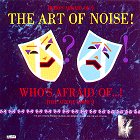 My first exposure to the Art of Noise was hearing the upbeat “Close (To The Edit)” on the end credits of some documentary about special effects and computer animation, and it stuck with me. When I finally found the album from which that song came, it was entirely different from anything I’ve heard before, though various elements of the Art of Noise sound have become fixtures in dance music here some twelve years later. Samples of loud, metallic crashes and bangs are common percussion elements, along with samples of other people’s music and voices. The beats are quirky and syncopated,
My first exposure to the Art of Noise was hearing the upbeat “Close (To The Edit)” on the end credits of some documentary about special effects and computer animation, and it stuck with me. When I finally found the album from which that song came, it was entirely different from anything I’ve heard before, though various elements of the Art of Noise sound have become fixtures in dance music here some twelve years later. Samples of loud, metallic crashes and bangs are common percussion elements, along with samples of other people’s music and voices. The beats are quirky and syncopated,  though elements of more conventional pop and even classical rear their heads occasionally. Hailing from 1984, this album’s sound may come across as dated to those accustomed to hearing drum machines and samples, but at the time there was nothing even remotely like it.
though elements of more conventional pop and even classical rear their heads occasionally. Hailing from 1984, this album’s sound may come across as dated to those accustomed to hearing drum machines and samples, but at the time there was nothing even remotely like it.

- A Time For Fear (who’s afraid?) (4:43)
- Beat Box (diversion one) (8:33)
- Snapshot (1:02)
- Close (to the Edit) (5:41)
- Who’s Afraid (of the Art of Noise?) (4:22)
- Moments in Love (10:17)
- Momento (2:14)
- How to Kill (2:44)
- Realization (1:41)
Released by: Zang Tuum Tumb
Release date: 1984
Total running time: 41:17
Electric Light Orchestra – Afterglow
 This wonderful three-disc set arrived at the height of my ELO-worship, but I only wish I’d had my CD player at the time. Very seldom in my music review pages will you hear me complain about the quality of anything other than the music itself, but here I have to offer you, the consumer, a strong warning: if you’re going to get Afterglow, get it on CD. Even if you don’t have a CD player, get the discs and have someone make you a copy of them on tape and then put the discs away. The cassettes on which Afterglow was duplicated were hideously cheap, and I went through two cassette copies of the third and most important volume of the set before I finally bought the CD box set. That’s the end of my consumer warning.
This wonderful three-disc set arrived at the height of my ELO-worship, but I only wish I’d had my CD player at the time. Very seldom in my music review pages will you hear me complain about the quality of anything other than the music itself, but here I have to offer you, the consumer, a strong warning: if you’re going to get Afterglow, get it on CD. Even if you don’t have a CD player, get the discs and have someone make you a copy of them on tape and then put the discs away. The cassettes on which Afterglow was duplicated were hideously cheap, and I went through two cassette copies of the third and most important volume of the set before I finally bought the CD box set. That’s the end of my consumer warning.
The reason the third CD is the most important is because it features several previously unavailable songs which were B-sides to singles from the 1980s, or were tracks deleted from Time and Secret Messages prior to pressing. The Time B-side “When Time Stood Still” is worth the cost of the entire set, being one of the best examples of what really made ELO great in the 80s. Other highlights of the “new” material include “Buildings Have Eyes”, the jazzy “No Way Out”, the dreamy “Mandalay”, and the epic-length and too-consciously-trying-to-be-Beatlesque “Hello My Old Friend”, all tracks which would have made 1983’s Secret Messages not only a double album, but a great double album, at least on a par with Out Of The Blue. The rest of the box set consists of usually well-chosen tracks from throughout the band’s history, though as always I like the album tracks better than the singles, so the box set’s emphasis  on ELO’s popular fare leaves me high and dry. Curious omissions from the set include the music from 1980’s Xanadu (removed from the set at the request of Jeff Lynne, according to Rolling Stone), and the beautiful instrumental B-side “After All”, which I only have as a scratched-up 45 and desperately want on CD. Perhaps someday…
on ELO’s popular fare leaves me high and dry. Curious omissions from the set include the music from 1980’s Xanadu (removed from the set at the request of Jeff Lynne, according to Rolling Stone), and the beautiful instrumental B-side “After All”, which I only have as a scratched-up 45 and desperately want on CD. Perhaps someday…
(Third disc only)
- Prologue (1:16)
- Twilight (3:33)
- Julie Don’t Live Here (3:40)
- Shine a Little Love (4:39)
- When Time Stood Still (3:33)
- Rain is Falling (2:57)
- Bouncer (3:13)
- Hello My Old Friend (7:51)
- Hold On Tight (3:06)
- Four Little Diamonds (4:08)
- Mandalay (5:19)
- Buildings Have Eyes (3:55)
- So Serious (2:39)
- A Matter of Fact (3:58)
- No Way Out (3:23)
- Getting to the Point (4:28)
- Destination Unknown (4:05)
- Rock ‘n’ Roll is King (3:07)
Released by: Epic
Release date: 1990
Total running time: 68:50
George Harrison – Cloud Nine
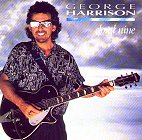 Okay, I admit it, I got this album mainly because ELO’s Jeff Lynne produced it with Harrison, as well as helping out with songwriting duties. The collaboration was a rare spark that re-ignited Lynne’s post-ELO career, and bested all of Harrison’s previous album sales. There was obviously some wisdom in pairing an ex-Beatle with a Beatle afficionado who had grown up learning all the nuances of the Beatles sound. In many places, though, it does sound like ELO with Harrison singing lead (the title track in particular sounds like it was lifted right off of Balance Of Power), though the best songs on the album are those where Harrison’s ability to craft a bittersweet or nutty pop tune were perfectly married to Lynne’s ability to produce such a song crisply. “Someplace Else”, “Devil’s Radio”, “This Is Love” and “That’s What It Takes” have always appealed to me much more than the two singles everyone remembers, the Beatles
Okay, I admit it, I got this album mainly because ELO’s Jeff Lynne produced it with Harrison, as well as helping out with songwriting duties. The collaboration was a rare spark that re-ignited Lynne’s post-ELO career, and bested all of Harrison’s previous album sales. There was obviously some wisdom in pairing an ex-Beatle with a Beatle afficionado who had grown up learning all the nuances of the Beatles sound. In many places, though, it does sound like ELO with Harrison singing lead (the title track in particular sounds like it was lifted right off of Balance Of Power), though the best songs on the album are those where Harrison’s ability to craft a bittersweet or nutty pop tune were perfectly married to Lynne’s ability to produce such a song crisply. “Someplace Else”, “Devil’s Radio”, “This Is Love” and “That’s What It Takes” have always appealed to me much more than the two singles everyone remembers, the Beatles  tribute “When We Was Fab” and the boringly repetitive number one hit “I Got My Mind Set On You”. Why this album has not been followed up on with this unique combination of talent is a complete mystery to me. While the Traveling Wilburys were fun, they didn’t offer the enormous possibilities of further Harrison-Lynne collaborations.
tribute “When We Was Fab” and the boringly repetitive number one hit “I Got My Mind Set On You”. Why this album has not been followed up on with this unique combination of talent is a complete mystery to me. While the Traveling Wilburys were fun, they didn’t offer the enormous possibilities of further Harrison-Lynne collaborations.
- Cloud 9 (3:15)
- That’s What It Takes (4:01)
- Fish On The Sand (3:25)
- Just For Today (4:06)
- This Is Love (3:45)
- When We Was Fab (3:58)
- Devil’s Radio (3:53)
- Someplace Else (3:53)
- Wreck of the Hesperus (3:34)
- Breath Away From Heaven (3:36)
- Got My Mind Set On You (3:50)
Released by: Dark Horse
Release date: 1987
Total running time: 41:16
Johannes Brahms – Sextet #1 in B Flat Maj. – Op. 18
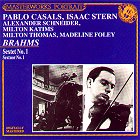 I’ll admit it, I only tracked this down after becoming obsessed with the short snippet of the Andante Ma Moderato movement featured in the Star Trek: The Next Generation episode Sarek. This CD pressing of a 1952 monaural performance sounds an awful lot like – no, make that exactly the same version used in a pivotal scene in that show. I was curious as to what else there was to this lovely piece of music, and was not disappointed; my interest in it has certainly
I’ll admit it, I only tracked this down after becoming obsessed with the short snippet of the Andante Ma Moderato movement featured in the Star Trek: The Next Generation episode Sarek. This CD pressing of a 1952 monaural performance sounds an awful lot like – no, make that exactly the same version used in a pivotal scene in that show. I was curious as to what else there was to this lovely piece of music, and was not disappointed; my interest in it has certainly  transcended the means through which I discovered it. If you’re into very heavy, funereal chamber music, I give this my highest recommendation; it’s one of my favorite classical pieces of all time. The slow, stately, mournful second movement alone is worth the price of purchase.
transcended the means through which I discovered it. If you’re into very heavy, funereal chamber music, I give this my highest recommendation; it’s one of my favorite classical pieces of all time. The slow, stately, mournful second movement alone is worth the price of purchase.
- Allegro ma non troppo (12:16)
- Adante, ma moderato (10:27)
- Scherzo – Allegro molto – Trio. Animato (2:53)
- Rondo – Poco allegretto e grazioso (11:08)
Released by: CBS Masterworks
Release date: 1952 (released on CD in 1988)
Total running time: 36:44
Moody Blues – Days Of Future Passed
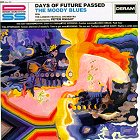 I’ll probably be lynched for saying this, but here goes: Days Of Future Passed, not Sgt. Pepper, was the best rock album to come out in 1967. I can buy the arguments that Lennon and McCartney are/were masterful songwriters, and even that Sgt. Pepper was a huge technical leap for rock music. But the sheer beauty and depth of emotion with which the Moody Blues imbued their most famous – and so far unparallelled – album puts it light-years of the material the Beatles were turning out at the time. Days of Future Passed paints a humblingly poetic view of the progression of a single day, and the music keeps getting better as the “day” in question goes on. Naturally
I’ll probably be lynched for saying this, but here goes: Days Of Future Passed, not Sgt. Pepper, was the best rock album to come out in 1967. I can buy the arguments that Lennon and McCartney are/were masterful songwriters, and even that Sgt. Pepper was a huge technical leap for rock music. But the sheer beauty and depth of emotion with which the Moody Blues imbued their most famous – and so far unparallelled – album puts it light-years of the material the Beatles were turning out at the time. Days of Future Passed paints a humblingly poetic view of the progression of a single day, and the music keeps getting better as the “day” in question goes on. Naturally  everyone remembers “Tuesday Afternoon” – which was here titled “Forever Afternoon (Tuesday?)” – and “Nights In White Satin”, but my all-time favorite Moody Blues song has to be the exotic Mike Pinder tune “The Sun Set”. The combination of an unusual rhythm and the flowing orchestral melody never fail to entrance me. It’s definitely on my DNP Album List.
everyone remembers “Tuesday Afternoon” – which was here titled “Forever Afternoon (Tuesday?)” – and “Nights In White Satin”, but my all-time favorite Moody Blues song has to be the exotic Mike Pinder tune “The Sun Set”. The combination of an unusual rhythm and the flowing orchestral melody never fail to entrance me. It’s definitely on my DNP Album List.
- The Day Begins (5:55)
- Dawn is a Feeling (3:48)
- Another Morning (3:56)
- Peak Hour (5:27)
- Forever Afternoon (Tuesday?) / (Evening) Time to Get Away (8:24)
- The Sun Set / Twilight Time (6:40)
- Nights in White Satin (7:32)
Released by: Deram
Release date: 1967
Total running time: 41:42
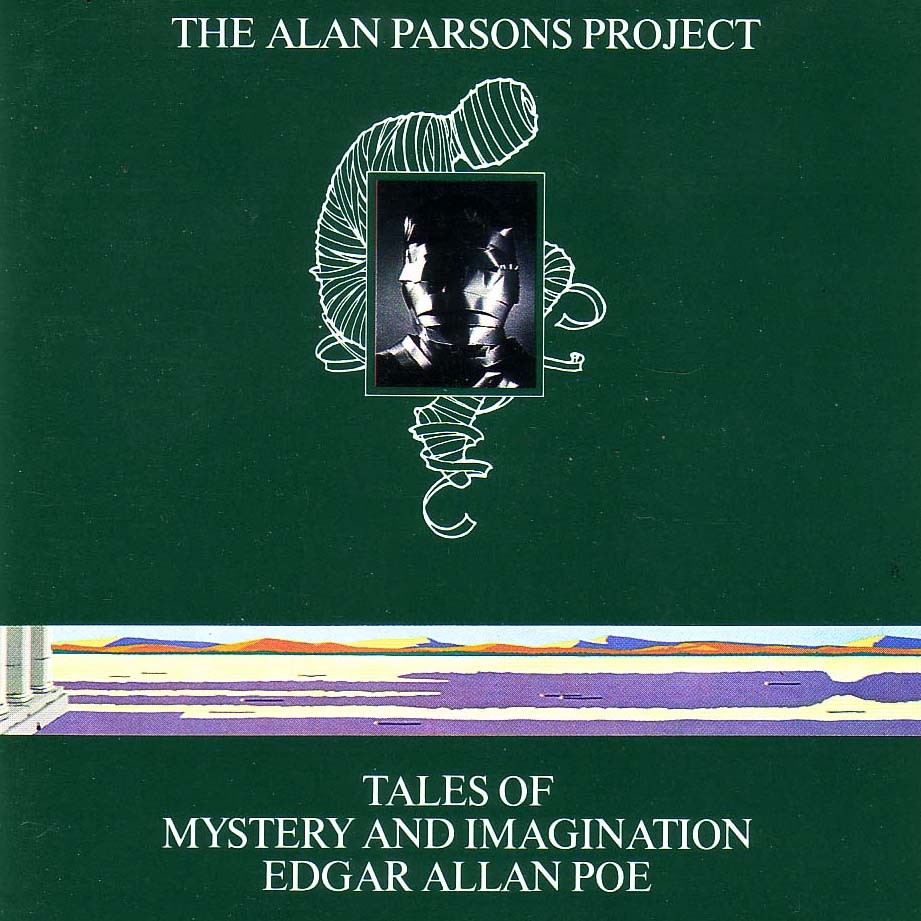
Alan Parsons Project – Tales of Mystery & Imagination
 This album kicks off a string of brilliantly executed studio concoctions attributed to a “band” of session musicians that have secured a place in my heart as one of my three favorite rock acts of all time. This first effort – which was originally intended to be the only one of its kind and, as such, was originally pressed on vinyl under the title of The Alan Parsons Project referring to the album and not the group performing it – sets the style for the remainder of the 1970s for the Project. A group of songs inspired by sundry poems and stories by Edgar Allan Poe ranges from chilling (“The Tell Tale Heart”, though a lot of the credit for the spinal shivers still belongs to the source material) to ethereally gorgeous (“To One In Paradise”, the last track). In between there lies mystery (“A Dream Within a Dream”, an instrumental which perfectly balances rock and classical elements, a Parsons
This album kicks off a string of brilliantly executed studio concoctions attributed to a “band” of session musicians that have secured a place in my heart as one of my three favorite rock acts of all time. This first effort – which was originally intended to be the only one of its kind and, as such, was originally pressed on vinyl under the title of The Alan Parsons Project referring to the album and not the group performing it – sets the style for the remainder of the 1970s for the Project. A group of songs inspired by sundry poems and stories by Edgar Allan Poe ranges from chilling (“The Tell Tale Heart”, though a lot of the credit for the spinal shivers still belongs to the source material) to ethereally gorgeous (“To One In Paradise”, the last track). In between there lies mystery (“A Dream Within a Dream”, an instrumental which perfectly balances rock and classical elements, a Parsons trademark in later years) and a huge, entirely instrumental orchestral suite depicting The Fall of the House of Usher, among other points of interest. The CD liner notes booklet is lavish and incredibly informative, and there’s an added treat in the form of two narrations recorded for the album by Orson Welles but omitted from the original LP release. Very uneven but highly recommended.
trademark in later years) and a huge, entirely instrumental orchestral suite depicting The Fall of the House of Usher, among other points of interest. The CD liner notes booklet is lavish and incredibly informative, and there’s an added treat in the form of two narrations recorded for the album by Orson Welles but omitted from the original LP release. Very uneven but highly recommended.
- A Dream Within A Dream (4:13)
- The Raven (3:57)
- The Tell-Tale Heart (4:38)
- The Cask of Amontillado (4:33)
- (The System of) Doctor Tarr and Professor Fether (4:20)
The Fall of the House of Usher:
- Prelude (7:02)
- Arrival (2:39)
- Intermezzo (1:00)
- Pavane (4:36)
- Fall (0:51)
- To One In Paradise (4:46)
Released by: Mercury
Release date: 1976
Total running time: 42:35
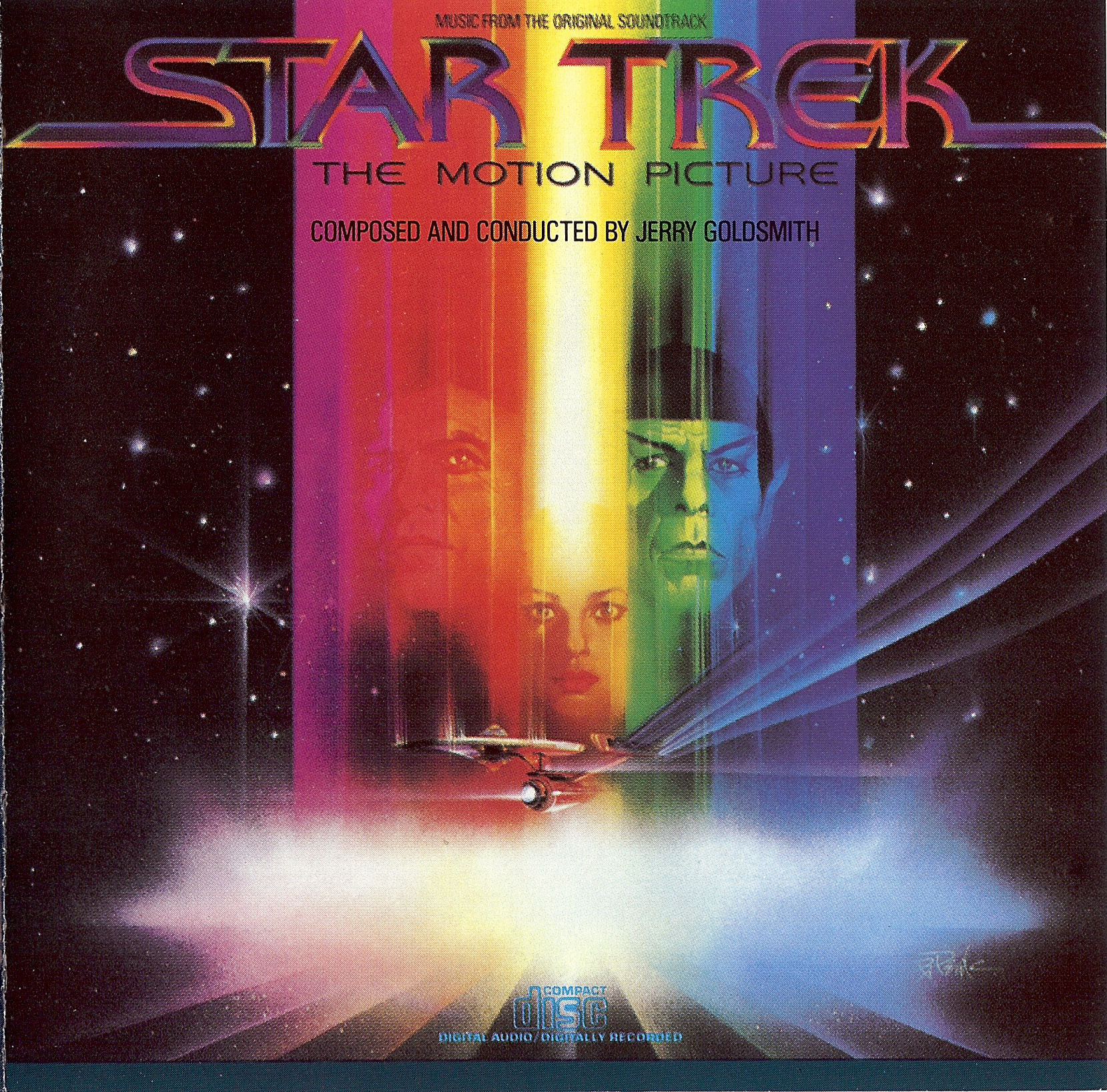
Star Trek: The Motion Picture – music by Jerry Goldsmith
This Oscar-nominated score redefined the musical mindset of Star Trek and set a standard by which all future music for the Star Trek entity, whether in the theater or on TV, would be judged. (Need proof? What music did Star Trek: The Next Generation use for its theme?) This definitive Trek movie score has yet to be surpassed or even so much as equalled – not even by Goldsmith himself, who scored the fifth, eighth, ninth and tenth movies in the Trek saga as well as coining the theme music for the Voyager spinoff series. The unique combination of contemporary, ancient and futuristic sounds for the first Star Trek movie is indicative of the enormous scope of the story, and makes for some excellent listening away from the sound effects and dialogue. The traditional orchestral complement combines with the distinctive sound of something (!?) called the Blaster Beam (the signature sound of this movie, it sounds not unlike the combination of a distorted electric guitar and a chainsaw) and the gothic tones of the organ to produce a sweeping, awe-inspiring atmosphere. Countering that effect, this was the only Trek movie to date which required a genuine, sweeping, romantic love theme – which really says more about the nature of the later Star  Trek films than their successive composers. Due to the length of the movie and the length of the overbudgeted special effects sequences, Goldsmith’s score is prominent throughout the film, and there’s a lot of it. This is easily the best score ever to have graced any of the Star Trek movies.
Trek films than their successive composers. Due to the length of the movie and the length of the overbudgeted special effects sequences, Goldsmith’s score is prominent throughout the film, and there’s a lot of it. This is easily the best score ever to have graced any of the Star Trek movies.
- Main Title / Klingon Battle (6:50)
- Leaving Drydock (3:29)
- The Cloud (5:00)
- The Enterprise (5:58)
- Ilia’s Theme (3:01)
- V’ger Flyover (4:56)
- The Meld (3:15)
- Spock Walk (4:17)
- End Title (3:16)
Released by: CBS
Release date: 1979
Total running time: 40:02
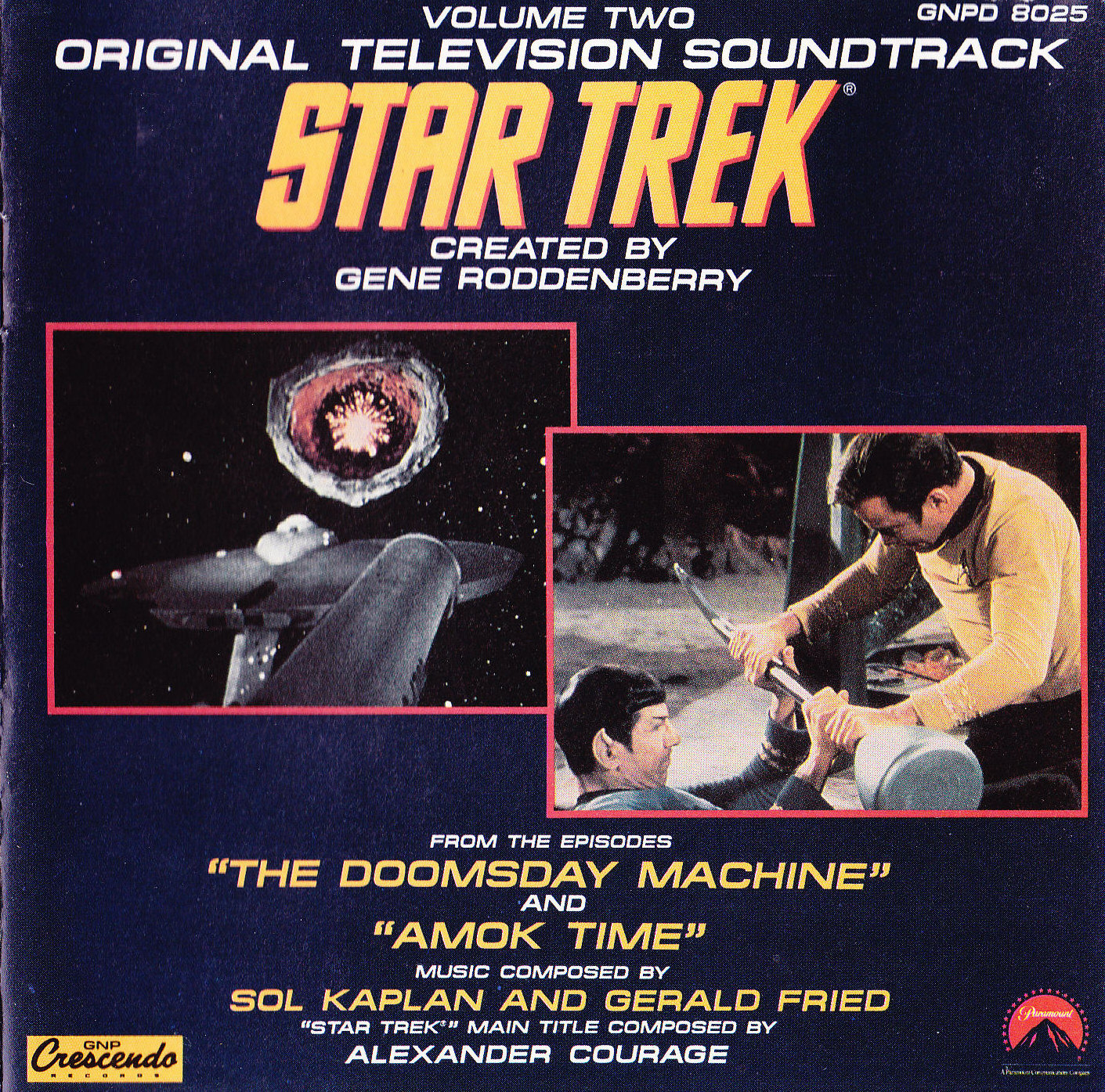
Star Trek: The Doomsday Machine / Amok Time
This is more like it. And the choice of episodes couldn’t be better – the two acclaimed second-season episodes featured some of the most memorable music to be heard from this point on in the series. The late Sol Kaplan’s familiar, belligerent Doomsday Machine action cues often underscored tense situations for the rest of the series, and Gerald Fried’s exotic bass guitar from Amok Time became the signature theme for all things Spockish or otherwise Vulcan. The mastering on the  album is outstanding, and the liner notes on the composers are interesting. Highly recommended for any fans of the original Trek.
album is outstanding, and the liner notes on the composers are interesting. Highly recommended for any fans of the original Trek.
- Star Trek main title (1:00)
The Doomsday Machine music by Sol Kaplan
- Approach of Enterprise / The Constellation (1:08)
- Going Aboard (1:38)
- Commander Matt Decker / The Crew That Was (1:56)
- What is Doomsday Machine / The Planet Killer (1:58)
- Strange Boom / Decker Takes Over (2:49)
- The New Commander / Light Beams / Tractor Beam (4:09)
- Violent Shakes (2:45)
- Spock Takes Command / Decker’s Foil / Sneaky Commodore (2:26)
- Goodbye Mr. Decker (3:10)
Condolences / Power Drain (1:09)
- Kirk Does It Again (3:45)
- One’s Enough (0:22)
Amok Time music by Gerald Fried
- Vulcan Fanfare / Prying (0:46)
- Mr. Spock (1:22)
- Contrary Order (2:58)
- T’Pring (0:47)
- Marriage Council (1:51)
- Vulcan (1:03)
- The Processional (1:36)
- The Challenge (3:02)
- The Ritual / Ancient Battle / 2nd Kroykah (5:25)
- Remorse / Marriage Council II (1:12)
- Resignation / Lazarus Return / Pig’s Eye (0:42)
- Star Trek end title (0:47)
Released by: GNP Crescendo
Release date: 1991
Total running time: 41:04
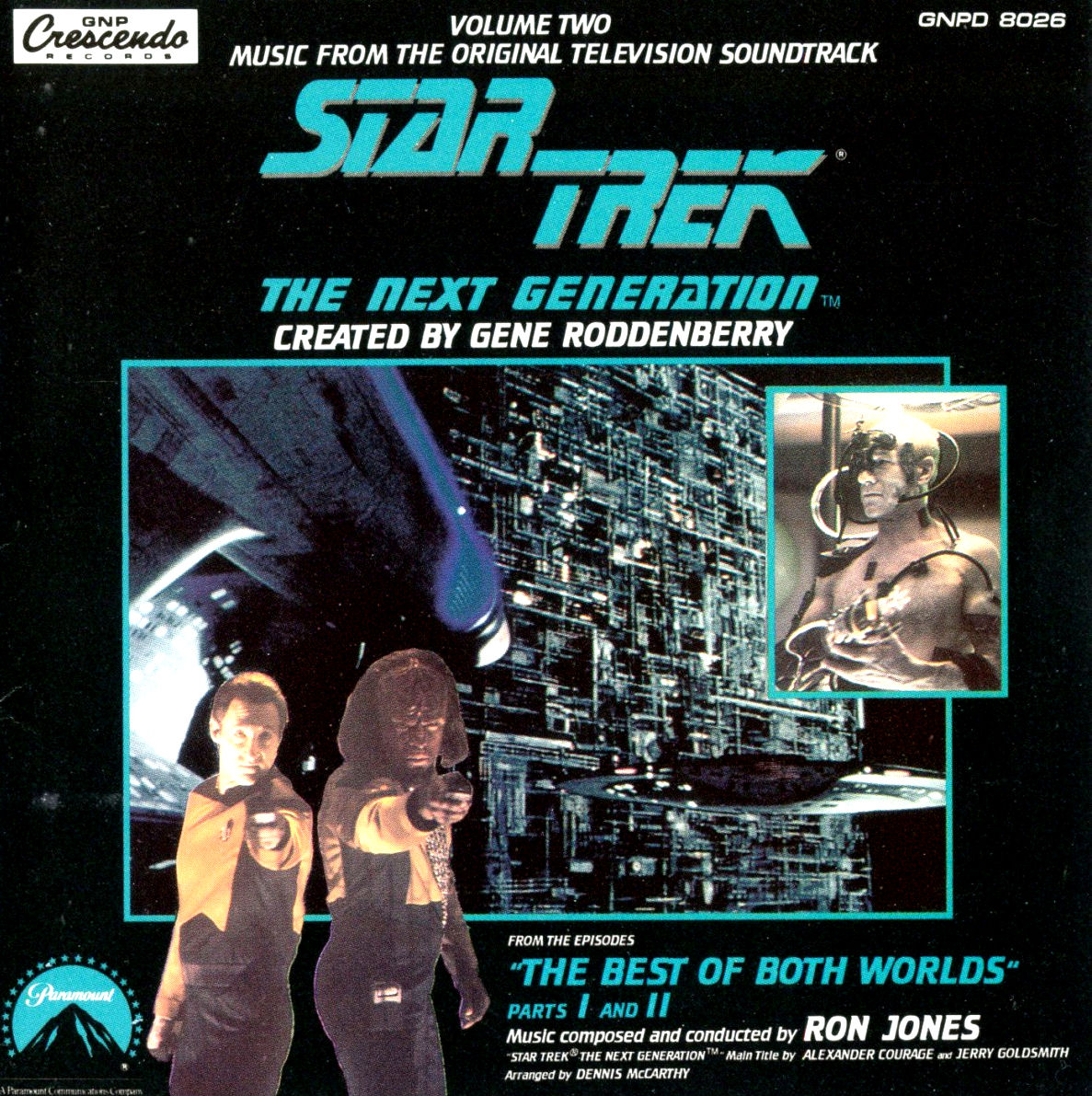
Star Trek: The Next Generation – Best Of Both Worlds
This 1990 two-parter rewrote the books of Star Trek history as it proved that the struggling new show could be just as formidable as the original series, if not much more so. You might remember Best Of Both Worlds as the cliffhanging two-parter in which Captain Picard is abducted and transformed by the Borg, but one of the things I remembered these two shows for the most was the music, which is quite unusual for the producer-mandated subdued scoring that usually drenches the show. Ron Jones graced the epic story with music that recalls John Williams’ Star Wars soundtrack, with added twists in the form of the haunting choral interludes for the Borg and a very heavy, doom-laden treatment for the second part. Best tracks include “First Attack”, “Captain Borg” (that’s the cliffhanger from part one with that world-ending “bam bam bam!” to-be-continued, end-of-the-world climax), “Intervention” and “The Link”. Despite the fact that it was eagerly received by the fans and in music  stores, it was a few years before Star Trek’s top brass allowed their composers to get this brassy again. Ron Jones himself left the show a year later, around the time of this album’s release, sick of the extensive strictures placed on the show’s music, and who can blame him? All the same, I’ve always wondered what miracles Jones could have worked on the episodes that followed his departure, to say nothing of Deep Space Nine.
stores, it was a few years before Star Trek’s top brass allowed their composers to get this brassy again. Ron Jones himself left the show a year later, around the time of this album’s release, sick of the extensive strictures placed on the show’s music, and who can blame him? All the same, I’ve always wondered what miracles Jones could have worked on the episodes that followed his departure, to say nothing of Deep Space Nine.
The Best of Both Worlds Part I by Ron Jones
- Star Trek – The Next Generation main title (1:40)
- New Providence (1:19)
- Hansen’s Message (1:28)
- Borg Engaged (1:16)
- First Attack (4:56)
- Borg Take Picard (3:03)
- Death Is Irrelevant (1:35)
- Away Team Ready (1:15)
- On the Borg Ship* (1:27)
- Nodes (2:55)
- Captain Borg (3:51)
The Best of Both Worlds Part II by Ron Jones
- Energy Weapon Fails (3:52)
- Humanity Taken (0:56)
- Contact Lost (0:34)
- Cemetery of Dead Ships (1:45)
- Intervention (4:21)
- The Link (2:58)
- Sleep Command (3:52)
- Destruct Mode / Picard is Back (1:36)
- Picard’s Nightmare (1:00)
- Star Trek: The Next Generation end credit (1:02)
* music not used in broadcast version of show.
Released by: GNP Crescendo
Release date: 1991
Total running time: 46:41
